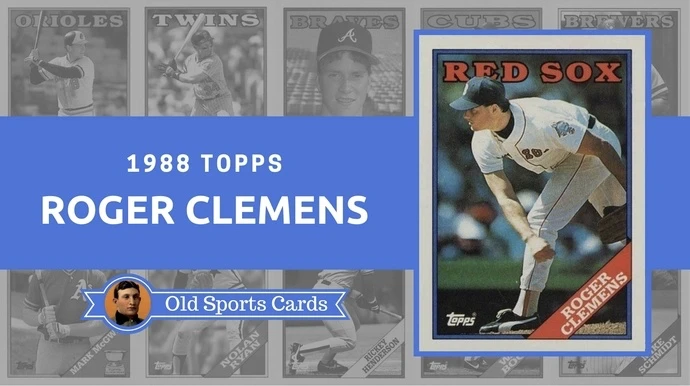
More...
There was a time when every kid in the hobby wanted to own a 1988 Topps Roger Clemens baseball card.
Heck, any Clemens card was a good one to have...
By the time Topps released his 1988 issue, Clemens was already a two-time Cy Young winner at just 25 years old.
Yet, as the baseball card bubble of the late 1980s and early 1990s burst, the value and interest in this card quickly dwindled.
And though Clemens continued adding to his incredible list of achievements thereafter, his eventual ties to PEDs put a further dent in the interest in his cards.
Still, with the recent renewed interest in the hobby from collectors of that era, this card does bring a certain level of nostalgia.
And in this guide, we'll look at what makes it unique, how much it's worth, and the best ways to buy and sell one.
Let's jump right in!

Ross Uitts - Owner
Love sports cards?
Get my weekly newsletter with the latest hobby updates delivered straight to your inbox!
1988 Topps Roger Clemens Value
Estimated Ungraded Value: $.50 - $1.25
The value of a 1988 Topps Roger Clemens card will depend on its condition and whether or not a third-party company like PSA has professionally graded it.
Typically, this card will sell between $0.50 - $1.25 if it is ungraded or "raw," as hobbyists like to say.
Two things really hurt the value of this card over time:
- Topps printed a massive amount of these during the "junk era."
- Clemens' ties to PEDs and absence from the Hall of Fame.
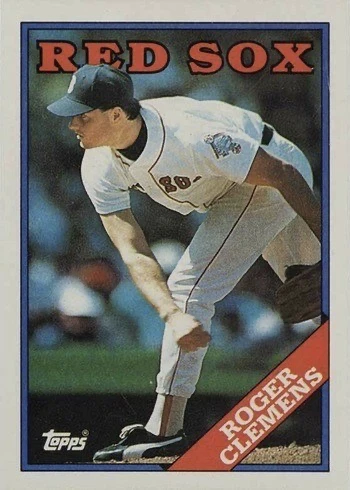
Prices for graded 1988 Topps Roger Clemens cards can vary wildly depending on the grade they receive for one simple reason: collectors are willing to pay higher prices for higher quality cards.
Most grading companies use a 1 - 10 scale to judge a card's condition, with 1 being the lowest and 10 the highest--the higher the grade the higher the value.
When assigning a grade, these companies will focus on four key areas:
- Centering: from top to bottom and left to right, centering should be as close to 50/50 as possible
- Corners: corners should be sharp with no signs of wear, bending or rounding
- Surfaces: the front and back surfaces should be free from any creasing, wrinkles, cuts, scratches or blemishes
- Edges: each of the edges should be free of any dings, dents or chipping
To give you an idea of differences in condition, notice the excellent centering, sharp corners, and beautiful surfaces of the PSA 10 Gem Mint card below versus the PSA 8 NM-MT:
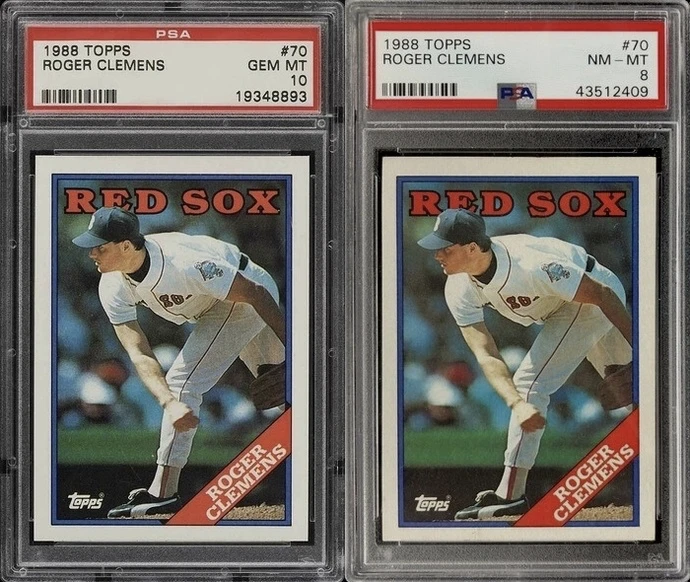
While the PSA 10 example boasts fantastic centering, sharp corners, clean edges and little to no surface issues, the PSA 8 shows a bit of corner wear and centering that appears to favor the bottom and left.
The higher values for this card don't really start to kick in until it achieves a 10 on the grading scale, as the estimates are as follows:
Estimated PSA 10 Gem Mint Value: $30
Estimated PSA 9 Mint Value: $10
Estimated PSA 1 - 8 Values: $2 - $5
1988 Topps Roger Clemens Facts and Insights
Roger Clemens made his Topps debut when his 1985 Topps rookie card began hitting shelves across the nation.
Though you might be surprised, it can still be worth hundreds of dollars in PSA 10 condition, as it remains one of the most iconic cards of the 1980s:
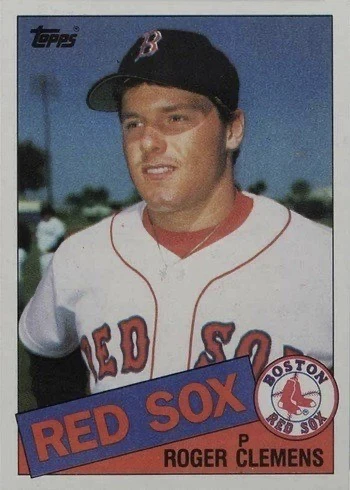
Unfortunately, his 1988 Topps issue will never reach the same kind of price tag as his rookie card.
Collectors typically pay substantial premiums for a given player's rookie card compared to other cards of that player.
But as I mentioned earlier, one of the main things dragging the price of his 1988 Topps card down is that there are still so many in circulation.
By the late 1980s, Topps and other manufacturers were printing cards like crazy to try and keep up with the hobby boom of that era.
Still, value aside, it's a great-looking card that captures a nice action shot of The Rocket during his delivery:

Compared to his 1988 Donruss and 1988 Fleer issues (image below), I think his 1988 Topps holds up the best among the three in terms of overall eye appeal.
The portrait on the Donruss card is slightly underwhelming but offset with that set's unique multi-color border design.
And, while the action shot on the Fleer card is arguably better since the angle is better, the overall look and feel of that set just wasn't as solid as Topps that year.
Here's a look at both so you can judge for yourself:
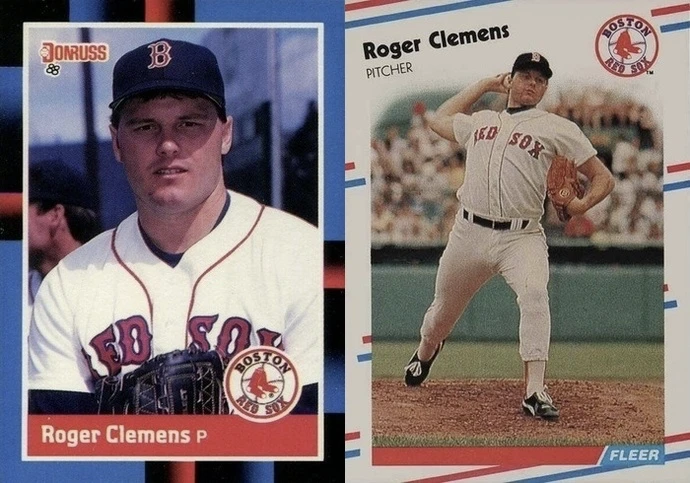
The reverse of the '88 Topps card uses a horizontal layout to display Clemens' card number, name, personal information, and Major League statistics from 1984 to 1987.
His 1986 breakout performance is especially noticeable with his MLB-best 24 wins and AL-best 2.48 ERA italicized as two of the eye-popping stats that led to Clemens capturing both Cy Young and MVP honors that season.
Below the stat box is a short write-up, for which Topps has always been famous for including on many of their cards, that reads:
- "At New Britain in 1983 Roger held oppoents to a .167 Average (31-for-186). In the Eastern League Playoffs he won his 2 Starts vs. Reading and Lynn. Roger signed as a 1st round Draft selection with the Red Sox, June 21, 1983 by Scout Danny Doyle."
As a kid, I always loved reading those small bits of trivia.
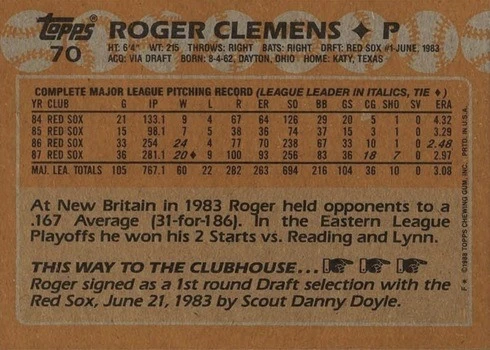
1988 Topps #70 Roger Clemens In Review
Coming off back-to-back Cy Young campaigns in 1986 and 1987, there was no question that Roger Clemens was among the league's most feared pitchers ahead of the 1988 season.
With a fastball clocking in at 98 mph and a sharp breaking ball, Clemens routinely had hitters off balance and out of rhythm.
And though he led the Majors in strikeouts (291), shutouts (8), strikeouts per nine (9.9), strikeouts to walks ratio (4.69) and FIP (.217), both of which were career bests, he surprisingly fell to sixth in the AL Cy Young vote.
Clemens even had 18 wins and a 2.93 ERA, to boot.
While his 7.1 WAR was the third-best among the pitchers who finished ahead of him, it was arguably Clemens' 12 losses that caused him to fall so sharply down the list.
Times have changed, but a pitcher's record played a much more significant role in his vote performance in that era.
Still, it was another fine season for a young stud pitcher seemingly on a direct track to Cooperstown.
Unfortunately, his late-career ties to PEDs will forever tarnish his legacy.
That controversy, combined with the sheer quantity of this card that Topps printed, will continue hurting its value.
Yet, if you were a Clemens or Red Sox fan or a kid who grew up collecting during the late 80s, this card will surely bring back plenty of memories.
